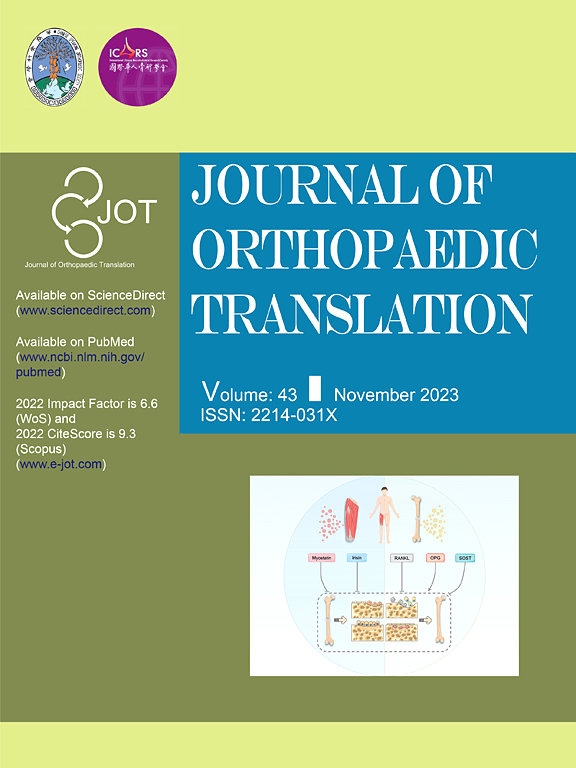运动对肩袖损伤后疼痛和焦虑的影响:室旁核突触可塑性的作用
IF 5.9
1区 医学
Q1 ORTHOPEDICS
引用次数: 0
摘要
背景:肩袖损伤(RCI)常导致慢性疼痛和焦虑,但其潜在的神经机制尚不清楚。本研究探讨了RCI与这些症状之间的中枢机制,并评估了跑步机运动(TE)作为小鼠治疗干预的作用。方法C57BL/6小鼠接受RCI手术,随机分为Sham组、RCI组和TE组(术后第7天开始TE)。机械超敏反应和焦虑样行为通过von Frey、高架迷宫和野外测试进行评估。采用免疫荧光、Western blotting、电镜、高尔基染色等方法对脑室旁核(PVN)突触可塑性蛋白和结构进行分析。利用TrkB抑制剂ANA-12检测脑源性神经营养因子-原肌球蛋白受体激酶B (BDNF-TrkB)通路的作用。结果rci引起PVN内突触结构的明显改变,表现为突触素表达减少,生长相关蛋白43表达增加,突触微结构异常。在小鼠模型中,这些突触修饰与痛觉过敏和焦虑样行为的表现相关。TE逆转了这些突触变化,改善了疼痛和焦虑症状。从机制上讲,TE激活了PVN中的BDNF-TrkB信号通路,这对其治疗效果至关重要。使用ANA-12对TrkB受体进行药物阻断会减弱TE的治疗效果,这证实了BDNF-TrkB信号通路的关键作用。结论te通过BDNF-TrkB信号通路恢复PVN突触可塑性,从而减轻rci相关的疼痛和焦虑,强调了运动的治疗潜力。该研究揭示了RCI后疼痛和焦虑的中枢神经机制的新见解,突出了PVN突触可塑性的变化。它阐明了外周损伤和中枢神经系统改变之间的联系,指导临床医生进行更有针对性和更有效的治疗。本文章由计算机程序翻译,如有差异,请以英文原文为准。

The effects of exercise on pain and anxiety following rotator cuff injury: the role of paraventricular nucleus synaptic plasticity
Background
Rotator cuff injury (RCI) often leads to chronic pain and anxiety, yet the underlying neural mechanisms remain unclear. This study explored central mechanisms linking RCI to these symptoms and assessed treadmill exercise (TE) as a therapeutic intervention in mice.
Methods
Male C57BL/6 mice underwent RCI surgery and were randomized into Sham, RCI, or TE groups (TE initiated on postoperative day 7). Mechanical hypersensitivity and anxiety-like behaviors were evaluated via von Frey, elevated plus maze, and open field tests. Synaptic plasticity proteins and structures in the paraventricular nucleus (PVN) were analyzed using immunofluorescence, Western blotting, electron microscopy, and Golgi staining. The brain-derived neurotrophic factor-tropomyosin receptor kinase B (BDNF-TrkB) pathway's role was tested using the TrkB inhibitor ANA-12.
Results
RCI elicited notable alterations in synaptic structure within the PVN, characterized by decreased synaptophysin expression, increased growth-associated protein 43 expression, and synaptic microstructural abnormalities. These synaptic modifications were correlated with the manifestation of hyperalgesia and anxiety-like behaviors in murine models. TE reversed these synaptic changes and improved pain and anxiety symptoms. Mechanistically, TE activated the BDNF-TrkB signaling pathway in the PVN, which was essential for its therapeutic effects. Pharmacological blockade of the TrkB receptor using ANA-12 attenuated the therapeutic benefits of TE, confirming the critical role of BDNF-TrkB signaling pathway.
Conclusion
TE mitigates RCI-related pain and anxiety by restoring PVN synaptic plasticity via BDNF-TrkB signaling, underscoring exercise's therapeutic potential.
The translational potential of this article
The study reveals new insights into the central neural mechanisms of pain and anxiety after RCI, highlighting synaptic plasticity changes in the PVN. It clarifies the link between peripheral injury and central nervous system alterations, guiding clinicians toward more targeted and effective treatments.
求助全文
通过发布文献求助,成功后即可免费获取论文全文。
去求助
来源期刊

Journal of Orthopaedic Translation
Medicine-Orthopedics and Sports Medicine
CiteScore
11.80
自引率
13.60%
发文量
91
审稿时长
29 days
期刊介绍:
The Journal of Orthopaedic Translation (JOT) is the official peer-reviewed, open access journal of the Chinese Speaking Orthopaedic Society (CSOS) and the International Chinese Musculoskeletal Research Society (ICMRS). It is published quarterly, in January, April, July and October, by Elsevier.
 求助内容:
求助内容: 应助结果提醒方式:
应助结果提醒方式:


